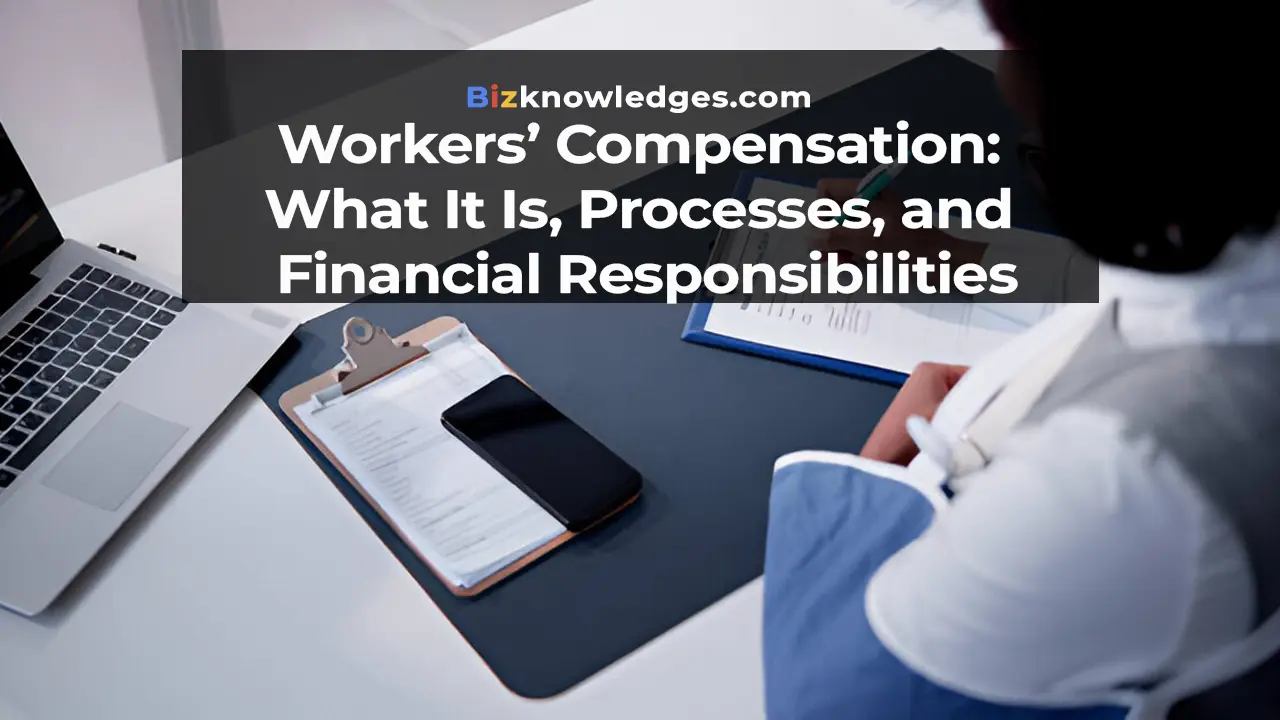Workers’ Compensation: What It Is, Processes, and Financial Responsibilities

What Is Workers’ Compensation?
Imagine this: You’re at work, the place where you spend a good chunk of your day, striving to contribute, grow, and maybe even climb the career ladder. But then, unexpectedly, you get injured. It could be a slip, a fall, or something more serious that requires medical attention. Now, not only are you in pain, but you might also worry about the medical bills and the time you need to recover without income. This is where workers’ compensation insurance comes into play.
Workers’ compensation is a type of insurance that provides wage replacement and medical benefits to employees who are injured or become ill as a direct result of their job. Enacted into law in the United States in the early 20th century, this insurance was designed to create a simpler and more efficient method for handling workplace disputes related to injury or illness. It removes the need for legal action by ensuring that employees receive proper care and support without the complications of proving fault, making it a crucial safety net.

The essence of workers’ compensation is simple: it promotes a safer, more secure workplace by protecting both employees and employers. Employees benefit from coverage of their medical expenses and compensation for lost wages, while employers gain protection from lawsuits that might arise due to workplace accidents. This mutual benefit helps maintain a stable environment where both parties are safeguarded against the unexpected twists and turns of occupational hazards.
Workers’ Compensation Insurance Definition
To further clarify, workers’ compensation insurance is a mandatory policy that employers carry to cover the unforeseen costs associated with work-related injuries and illnesses. This insurance plays a critical role in the business ecosystem, acting as a form of social insurance where the costs are shared and managed collectively.
How does it work? Essentially, when an employee gets injured on the job or falls ill due to work-related reasons, workers’ compensation insurance steps in to cover expenses such as medical care, rehabilitation, and a portion of their lost wages. It can also provide disability benefits, whether temporary or permanent, depending on the severity of the injury. Moreover, in the unfortunate event of a worker’s death, the policy covers funeral expenses and provides benefits to the dependents of the deceased.

From a legal standpoint, having this insurance shields employers from most lawsuits by employees who suffer a workplace injury. This coverage is not just a safety measure but a legal requirement in most states, ensuring that businesses comply with local laws and regulations. The exact requirements and benefits can vary widely from one state to another, which dictates the specific terms of coverage and the process of claim filing.
Workers’ Compensation Benefits
Navigating the aftermath of a workplace injury can be daunting. Fortunately, workers’ compensation insurance provides a broad spectrum of benefits designed to ease this burden, encompassing more than just basic medical care. These benefits are crafted to address the various consequences of workplace injuries, from the immediate need for medical attention to long-term recovery and financial stability.
Medical Care: The cornerstone of workers’ compensation benefits is comprehensive medical coverage. This includes all necessary medical expenses related to the injury or illness, such as hospital visits, medications, surgeries, and emergency care. Additionally, it covers ongoing treatments like physical therapy and rehabilitation, ensuring that employees have access to the care they need to make a full recovery.
Disability Benefits: Depending on the severity and duration of the injury, workers may be eligible for disability benefits. These are categorized into four types:
- Temporary Total Disability (TTD): If an employee is unable to work at all but is expected to recover fully, they receive TTD benefits.
- Temporary Partial Disability (TPD): If an employee can work but not at their full capacity or full hours, TPD benefits help make up the difference in earnings.
- Permanent Total Disability (PTD): For injuries that prevent an employee from returning to any kind of gainful employment, PTD benefits are provided.
- Permanent Partial Disability (PPD): If an injury results in a permanent impairment but does not completely limit the employee’s ability to work, they may receive PPD benefits.
Wage Replacement: Typically, workers’ compensation pays a portion of an employee’s wages if they are unable to work due to a work-related injury or illness. This benefit is crucial as it provides financial relief during recovery, helping workers meet their living expenses without the stress of losing their entire income.
Death Benefits: In the tragic event that an employee dies as a result of a work-related injury, workers’ compensation insurance provides death benefits to the dependents of the deceased. These benefits often include a lump sum payment and may cover funeral and burial expenses, providing critical support during a challenging time.
Rehabilitation: For employees needing help to return to work or gain new skills for different employment, vocational rehabilitation benefits are available. This support can include job training, resume writing assistance, and even tuition coverage for necessary education.
Types of Workers’ Compensation
Workers’ compensation covers a variety of scenarios, each tailored to address the specific needs arising from different types of work-related injuries and illnesses. Understanding these types can help employees and employers alike navigate the complexities of claims and ensure that the appropriate benefits are provided. Here’s a look at the main categories:

Medical-Only: This is the most basic form of workers’ compensation, covering medical expenses for injuries that do not require an employee to take time off beyond a few days. Typically, employees return to work shortly after the incident, and the primary need is for immediate medical treatment. Medical-only claims are common for minor injuries and are crucial in preventing small issues from developing into serious conditions.
Temporary Disability: When an injury or illness temporarily prevents an employee from working at full capacity or at all, temporary disability benefits kick in. These are divided into:
- Temporary Total Disability (TTD): Benefits are provided when an employee is completely unable to work for a temporary period.
- Temporary Partial Disability (TPD): Benefits are provided when an employee can still work, but their earning capacity is temporarily reduced due to their injury or illness.
Permanent Disability: This type addresses more severe cases where an injury or illness results in a permanent impact on an employee’s ability to work. Permanent disability is further categorized into:
- Permanent Total Disability (PTD): For injuries that permanently prevent an employee from engaging in any gainful work.
- Permanent Partial Disability (PPD): For injuries that result in a permanent disability, but the employee can still engage in some form of work.
Vocational Rehabilitation: If an injury prevents an employee from returning to their previous job, vocational rehabilitation benefits can help them train for a new role. This can include career counseling, job training, and educational assistance to help integrate them into new employment suited to their capabilities post-injury.
Death Benefits: Should a worker succumb to their injuries, workers’ compensation provides death benefits to their dependents. This includes financial assistance and can cover funeral and burial expenses, aiming to reduce the financial burden on the family during a time of loss.
How is the Cost of Workers’ Compensation Insurance Determined?
Understanding how the cost of workers’ compensation insurance is calculated can seem complex, but it’s crucial for both employers and employees to grasp the fundamentals. This knowledge can help in planning and managing the financial aspects of business operations. Here’s a breakdown of the key factors that influence the cost of workers’ compensation insurance:
1. Payroll Size: The total payroll of a company is one of the primary factors in determining workers’ compensation premiums. Generally, the premium is calculated per $100 of payroll. This means that larger organizations with higher payrolls might see higher absolute costs, but the relative cost per employee can vary depending on other factors.
2. Industry Risk: Different jobs carry different levels of risk. Insurance companies categorize industries with a classification system, where each class has a corresponding rate based on the historical risk of injury in that field. For example, construction workers face higher risks of physical injury than office workers, leading to higher rates for construction companies.
3. Claims History: Also known as the experience modification factor, this aspect considers the history of past claims made by the company. A higher number of claims or more severe incidents can lead to higher premiums. Conversely, a clean safety record with few or no claims can lower the premium, incentivizing companies to maintain safe workplaces.
4. State Regulations: Workers’ compensation is regulated at the state level, and each state has its own rules and rates. These can vary widely, impacting the cost significantly depending on where the company operates. Some states may have higher insurance rates due to more generous benefit levels or higher medical costs.
5. Safety Programs: Many insurers offer discounts or incentives for businesses that implement effective safety and training programs. These programs can reduce the likelihood of workplace injuries and illnesses, thus potentially lowering the cost of insurance over time.
Premium Calculation Example: Let’s say a business has a payroll of $500,000, operates in a moderately risky industry with a rate of $1.50 per $100 of payroll, and has a good safety record with an experience modifier of 0.90. The annual premium would be calculated as follows:
How Much Does Workers’ Compensation Cost?
The cost of workers’ compensation insurance varies significantly depending on several factors, such as the type of business, location, and past claims history. To give a better understanding, let’s break down how much workers’ compensation typically costs for employers, and how these expenses can fluctuate.

1. Average Costs Across Industries:
On average, workers’ compensation costs employers about $0.70 to $2.00 per $100 of payroll, but this rate can vary widely. For example:
- Low-risk jobs like administrative or clerical positions might see rates on the lower end, sometimes below $0.30 per $100 of payroll.
- High-risk industries like construction or manufacturing can face much higher premiums, ranging from $2 to $5 or even more per $100 of payroll, due to the inherent risks of physical injury on the job.
2. Factors Affecting Costs: As previously discussed, several elements affect the cost of workers’ compensation insurance, including:
- Industry Type: Higher-risk industries, such as construction, manufacturing, and transportation, incur higher premiums than lower-risk industries like retail or office-based work.
- State Regulations: Each state has its own workers’ compensation requirements, benefit levels, and cost structures. For example, states with higher benefit mandates or medical costs will generally have higher premiums. In California, for instance, businesses tend to pay more due to high medical costs and more generous benefit programs, whereas states like Texas might have lower average rates.
- Experience Modifier (Claims History): Companies with a history of workplace accidents and claims will have higher premiums compared to businesses with fewer claims. Safety-conscious companies that invest in employee training and workplace safety programs may see lower costs over time through discounts and lower claims.
3. National Averages: The national average for workers’ compensation insurance costs in the U.S. is approximately $936 per employee per year. However, this number can fluctuate dramatically depending on the factors mentioned above. A small office-based business could pay significantly less than this, while a large construction firm might face much higher costs.
4. Examples by Industry:
- Retail: A retail store might pay around $0.75 to $1.00 per $100 of payroll. This means a company with an annual payroll of $300,000 would pay approximately $2,250 to $3,000 per year for workers’ comp insurance.
- Construction: Due to the higher risk of injury, construction businesses might pay between $2.00 to $5.00 per $100 of payroll. For a company with a $500,000 payroll, the cost could be $10,000 to $25,000 annually.
- Manufacturing: With similar risks to construction, manufacturing companies might pay around $1.50 to $3.00 per $100 of payroll. A business with a $1,000,000 payroll would then pay between $15,000 and $30,000 per year.
5. Cost Reduction Strategies: Businesses can actively work to lower workers’ compensation costs by:
- Implementing and maintaining robust safety programs to reduce workplace injuries.
- Offering training programs to educate employees on best practices and safe working methods.
- Providing return-to-work programs that facilitate employees’ transitions back to work after an injury, which can lower the costs associated with long-term disability claims.
- Exploring group insurance options or working with brokers to find cost-saving policies tailored to their specific industry and risk level.
How Do You Apply for Workers’ Compensation?
If you’ve been injured on the job or fallen ill due to work-related circumstances, applying for workers’ compensation is a vital step to ensure that you receive the medical care and financial support you need. The process may seem intimidating at first, but following the correct steps can make it much smoother and faster. Here’s a comprehensive guide on how to apply for workers’ compensation.
1. Report the Injury or Illness Immediately:
The first and most crucial step is reporting the injury or illness to your employer as soon as it happens. Many states have strict deadlines for reporting workplace injuries, often ranging from 24 hours to 30 days. Failing to report within this time frame can jeopardize your eligibility for benefits. It’s always a good idea to report any injury, even if it seems minor at first, because some injuries can worsen over time.
2. Seek Medical Attention:
After reporting the incident, seek medical care immediately. In some cases, your employer may provide a list of approved healthcare providers that you must use for your initial treatment. Be sure to follow your employer’s guidelines for medical treatment to ensure the costs are covered under workers’ compensation. Your medical provider will assess your injury, provide treatment, and create documentation that will be crucial for your claim.
3. File a Workers’ Compensation Claim:
Once your injury has been reported and you’ve received medical care, the next step is to officially file a workers’ compensation claim. Your employer or their insurance company typically provides the necessary forms. Depending on the state, this may be a Form WC-1, First Report of Injury, or a similar document. Make sure to fill out all required sections of the form thoroughly, providing details of the incident, injury, and any medical treatment you’ve received.
In many cases, your employer is responsible for submitting the claim to their workers’ compensation insurance provider. However, in some states, you may need to file the claim directly with the state workers’ compensation board or the insurance company. Always follow up to ensure the claim has been properly submitted.
4. Keep Detailed Records:
Throughout the process, it’s essential to keep thorough records of everything related to your injury, including:
- Medical visits and treatment plans
- Bills, receipts, and medical reports
- Correspondence with your employer, doctors, and insurance representatives
- Time missed from work due to the injury
This documentation will support your claim and help ensure that you receive the appropriate benefits.
5. Wait for Claim Approval or Denial:
Once your claim has been submitted, the insurance company will review the details. They may reach out to your employer, medical providers, and possibly even you for additional information. After the review process, the insurance company will either approve or deny your claim. If approved, you’ll begin receiving benefits, including coverage for medical expenses and wage replacement. In some cases, temporary disability or rehabilitation benefits might also apply.
6. What to Do If Your Claim Is Denied:
If your workers’ compensation claim is denied, don’t panic—denials happen, and there are steps you can take to appeal. First, review the reason for the denial, which should be clearly stated in the notification you receive. Common reasons for denial include failure to report the injury on time, disputes over whether the injury was work-related, or incomplete documentation.
To appeal the decision, you will likely need to file a formal appeal with your state’s workers’ compensation board. Each state has its own process and deadlines, but this often involves attending a hearing where you can present additional evidence, such as medical records, witness statements, or expert testimony, to support your case.
7. Returning to Work:
Once you’ve recovered enough to return to work, you may need to participate in a return-to-work program. This may involve modified duties or a gradual return to full-time work, depending on your condition. Returning to work as soon as you’re medically able can also help reduce the financial impact on both you and your employer.
Final Thoughts
Applying for workers’ compensation can be a detailed process, but by following these steps, you can ensure that your claim is properly handled and that you receive the benefits you’re entitled to. If you’re ever unsure about any part of the process, it’s wise to consult with a workers’ compensation attorney or a representative from your state’s workers’ compensation board to get the guidance you need.
